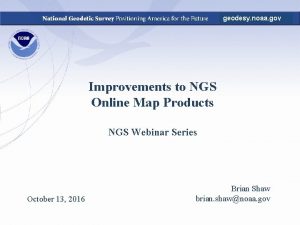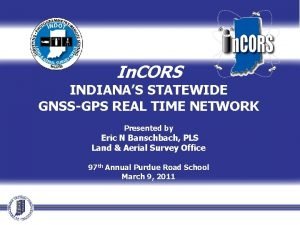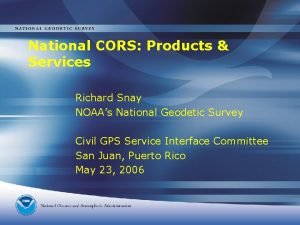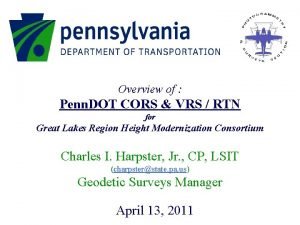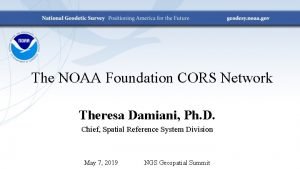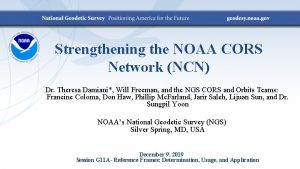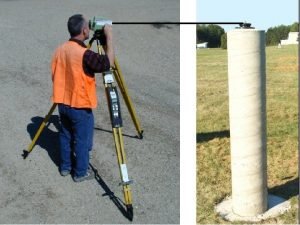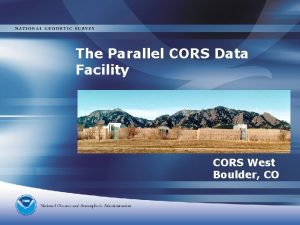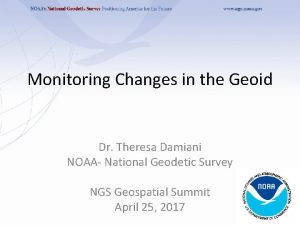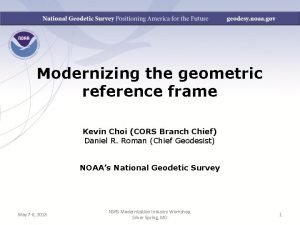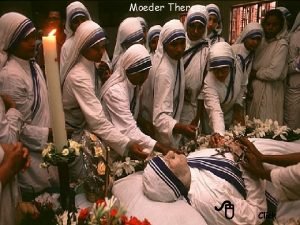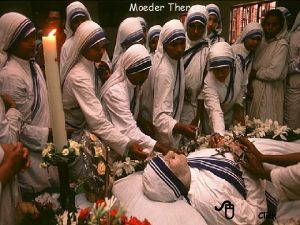Modernizing the NOAA CORS Network Theresa Damiani Ph









- Slides: 9

Modernizing the NOAA CORS Network Theresa Damiani, Ph. D. Chief, Spatial Reference System Division May 7, 2019 NGS Geospatial Summit

Outline What is a CORS? How many are there? What are they for? How valuable are they? How accurate are they? What is their future?

What is a CORS? • A Continuously Operating Reference Station (CORS) • Records signals of position and time from satellites in orbit – GPS (U. S. Global Positioning System) – Sometimes GNSS (Global Navigation Satellite Systems) owned by other countries • Located, monumented, and operated to provide geodetic-quality control • CORS managed by NGS are part of the NOAA CORS Network

Snapshot of the NOAA CORS Network • ~1900 GPS/GNSS CORS – Run by various agencies and research groups – Largest sector of contributors is state government (DOTs and geodetic offices) – Largest single contributor is the National Science Foundation – Founded in 1994 Satellite Systems Observed GPS (U. S. ) only GPS + GLONASS (Russian) GPS + GLONASS + Galileo (E. U. ) # of CORS 524 1075 169

Uses of the NOAA CORS Network • Define and provide access to the National Spatial Reference System • CORS quality: residual RMS < 2 cm horizontal, 4 cm vertical (~3/4”, 1. 6”) • Monitoring tectonic plate motion, rotation • Provide active control for GPS positioning through OPUS • Control for the surveying and mapping industry • NOAA applications: nautical chart references, tide gauge references, space weather models • Other federal applications: FEMA floodplain maps, USGS topographic maps and interior water management

Socio-Economic Value A 2008 economic benefit study valued CORS at $583 million A new NGS-estimated update to that study values CORS at $2. 61 billion Despite an increase in demand, the number of CORS has been near the limit that NGS can support for 7 yrs.

New CORS Coordinates/Velocities • The NGS CORS Network has two sets of coordinates and velocities for each station- in the national and international reference frames • Multi-Year CORS Solution 2 (MYCS 2) On BETA now • NAD 83 (2012) epoch 2010 and ITRF 2014 epoch 2010 • 1994 -2017, ~ 3050 stations: All active CORS, decommissioned CORS, and International GNSS Service (IGS) stations. Upcoming NGS • Improvements over MYCS 1 (completed in 2011) • • Webinar in June! ~1800 active + ~800 decommissioned CORS stations (~450 more than 2011) 7 more years of data Nearly 1000 more CORS have official computed coordinates and velocities ~240 new CORS (<3 yrs old) with approximate “modeled” coordinates and velocities

NOAA CORS Network Quality % of Stations # of Stations Horizontal Motion Vertical Motion 64% 1139 <= 3 mm AND <= 6 mm 35% 623 <= 5 mm AND <= 10 mm 1% 16 > 5 mm OR > 10 mm

Modernizing the NOAA CORS Network • Provide access to the National Spatial Reference System (NSRS) • Maintain quality of: 5 mm horizontal, 10 mm vertical (0. 2”, 0. 4”) • That’s nearly 75% BETTER than before; all but 16 CORS will meet standard • CORS Comprehensive Plan (Fall 2020) • • • Automate CORS network management and metrics (quality, availability, etc. ) Increase CORS partner communications Better models of motion, for both plate rotation and regional motion (IFVM) Provide an RTN-alignment service (RAS) Improvements to OPUS for selection of CORS website redesign
